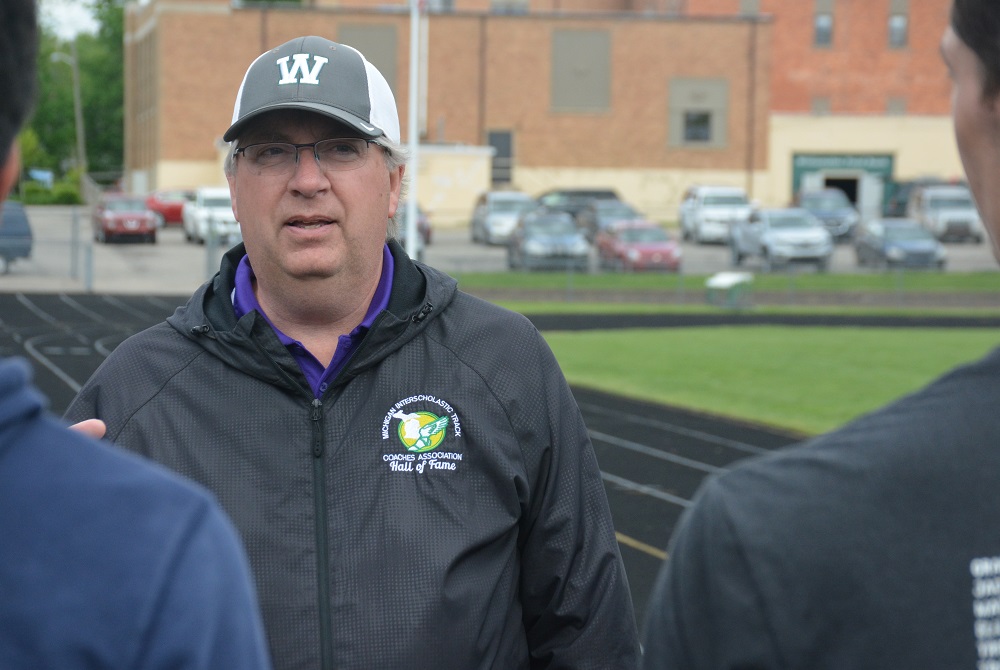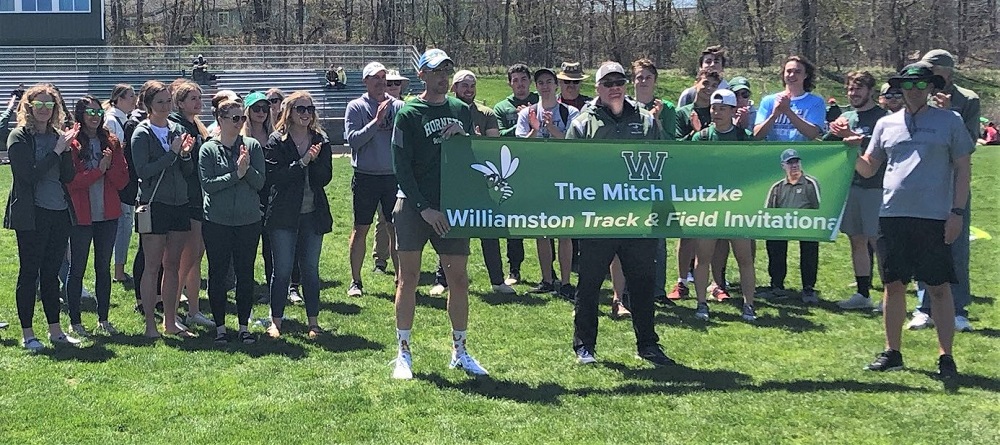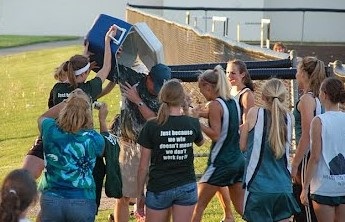
1970s Pioneers Took 1st Track Strides
May 16, 2017
By Ron Pesch
Special for Second Half
Between 1982 and 1987, Sue Latter-Addison was considered among the top 10 women runners for the 1,500 meters/Mile according to Track and Field News.
In 1986, she became only the eighth female in U.S. history to break 4:30 in the mile with a time of 4:23:93 at the Nikaia meet in Nice, France. Over the years, she ran with and against some of the greatest of all-time, including Mary Decker-Slaney. As a junior at Michigan State in 1977, she earned All-American honors in the outdoor 800 meters.
As a coach, she was named NCAA Division III Midwest Region Women’s Cross Country Coach of the Year in 1999, in her third season at Wheaton College. Her previous coaching stops included stints at Brown University, Colorado, Florida State, and most recently at Hope College. Running professionally for Reebok and Nike, she competed around the world.
“We were fortunate to come along when we did,” said Latter-Addison, recalling some of the track trailblazers and a time when participating in high school sports was not a possibility for girls. “If we had been born a couple of years before, we wouldn’t have had the opportunities that we did.”
Sue Latter was a 16-year old junior at Clarkston High School in January 1973 when the 6th U.S. Circuit Court of Appeals upheld a 1972 ruling that allowed girls to compete in varsity, non-contact sports with boys in Michigan. Since her high school didn’t have a girls track team, she joined the boys team.
“(Running with the boys) had advantages and disadvantages,” she said a few years later to the Lansing State Journal while running for MSU. “It did make me work harder, and my teammates were always encouraging me.”
The arrival of the first MHSAA Girls Track and Field championships in 1973, won by Marquette in the Upper Peninsula and by Lincoln Park in the Lower Peninsula, was the culmination of many things.
 The nation’s view of the female in society was rapidly changing. In many cases, the battle for the chance to compete against others was led by parents who believed in the educational value of athletics, and saw that opportunity denied because of gender. Thanks to their efforts, walls that prevented girls from enjoying opportunities that once were exclusively reserved for males began to crumble. Among those barriers were rules that prevented girls from competing athletically. Title IX, along with other lesser known lawsuits, meant rapid expansion of sports in Michigan and across the United States.
The nation’s view of the female in society was rapidly changing. In many cases, the battle for the chance to compete against others was led by parents who believed in the educational value of athletics, and saw that opportunity denied because of gender. Thanks to their efforts, walls that prevented girls from enjoying opportunities that once were exclusively reserved for males began to crumble. Among those barriers were rules that prevented girls from competing athletically. Title IX, along with other lesser known lawsuits, meant rapid expansion of sports in Michigan and across the United States.
A survey of MHSAA member schools during the 1969-70 school year found 59 districts offered track for girls. A year later, 69 schools offered the sport. In April of 1972, the MHSAA announced plans to expand girls state tournaments to five sports – Tennis, Swimming, Gymnastics, Golf, and Track – during the 1972-73 school year. One year previous, gymnastics was the only one offered, beside skiing regionals that allowed teams containing males and females.
With the announcement, the number of girls prep track programs shot up to 150. However, Clarkston wasn’t amongst them.
A new sport called Powerball – a version of competitive volleyball – was added to the athletic menu at Clarkston during the 1972-73 school year. The girls converted from six-girl basketball to a five-girl team during the 1969-70 school year. The “ball” sports were the only athletic options, outside of cheerleading and skiing, that were offered by the Clarkston district for girls during the 1972-73 season.
“I liked competing and enjoyed running and realized I was pretty fast,” recalled Latter-Addison. “Obviously there wasn’t much to choose from. I liked individual sports, where you’re responsible for yourself and your own success. Coach, (Errol) Solley gave me a chance.”
“She had a lot of talent,” said Solley, now a resident of Florida who returns to Michigan for the summers. “She wanted to run. We didn’t have a girls team at the time. It was a time when things were changing and changing fast.”
A few other girls had joined Latter on the team, but by the 1973 track season’s end, she was the only female still working out with the boys. Solley entered her in the girls regional state meet at Madison Heights, where she won the 880 and 440-yard dashes. With the wins, Latter advanced to the state meet, hosted at East Lansing High School.
She was one of 366 entrants from 119 schools at the Lower Peninsula meet, open to all schools regardless of enrollment classification in that first year. In the Upper Peninsula, 29 teams competed at Iron Mountain for U.P. honors. In 1974, the L.P. girls event was split into two, one for Class A and B schools and a second for Class C and D schools. In 1975, events were run for each of the state’s enrollment classifications. In the U.P., the event was segmented into Class A-B, Class C and Class D beginning in 1974.
And, like many others, Latter was the only qualifier present to represent her high school. According to the State Journal, Latter’s clocked time of 57.1 seconds set a national schoolgirl record in the 440-yard dash that year. She also won the 880 run with a time of 2:17.7.
Solley proudly relayed word to the Clarkston News that the University of Michigan girls coach had said he “hadn’t seen anything like her comeback from 880 to the 440 within an hour.”
“She opened up a lot of eyes,” recalled the coach more than 40 years later. “When you have a girl win two state championships, that will happen.”
 Running second in the 880 was Sue Parks of Ypsilanti High School, who finished at 2:18.3. Park’s father Bob was head coach of Eastern Michigan University’s men’s track and field and cross country teams for 34 years. Like others, he had fought hard for his daughter’s right to run, and the 1971-72 school year found her practicing with the track team at Ypsilanti.
Running second in the 880 was Sue Parks of Ypsilanti High School, who finished at 2:18.3. Park’s father Bob was head coach of Eastern Michigan University’s men’s track and field and cross country teams for 34 years. Like others, he had fought hard for his daughter’s right to run, and the 1971-72 school year found her practicing with the track team at Ypsilanti.
Anita Lee of Detroit Cass Tech was the day’s other double winner. In 1970 as a 12-year-old, Lee’s name landed in “Faces in the Crowd,” still a feature of every issue of Sports Illustrated, for setting “her seventh world age-group record with a long jump of 18'6¼" at the U.S. Youth Games in New York.” According to the magazine, she already held the 10-, 11- and 12-year-old girls world records in both the long and high jumps.
A sophomore in 1973, Lee won both the long and high jump in the MHSAA’s open meet. A year later at the Class A-B track championships, she won the long jump, the 80-yard hurdles, then ran the opening leg of the 880 relay, also won by Cass Tech. As a senior in 1975, Lee grabbed the top medals in both the long jump and high jump at the Class A championships. Like Latter, she would compete at Michigan State after graduation. There, she would post jump records that would last for years.
“When you have success, it is addicting,” said Latter-Addison.
Unfortunately, Latter’s success didn’t translate into a girls track team. Clarkston still didn’t sponsor a girls squad in 1974, her senior year. So she and some other female classmates accepted their only option and ran with the boys squad. Now running the 100 and 220, Latter was Oakland County champ in both events at the first county meet, held at West Bloomfield High School. Ready to return to statewide competition, suddenly a roadblock appeared.
“A question of Sue’s eligibility arose last weekend as she and three other Clarkston High School girls prepared to run in the regional meet” at Madison Heights Madison, stated the Clarkston News that May.
“Because Clarkston did not field enough girls for a girls track team, the co-eds had practiced with the boys’ team and ran practice in their meets. They … ran afoul of a new athletic rule which says that a boy or girl must elect which team they will enter competition with.”
As explained by a school official, “if a girl decides to play with the boys’ tennis team, for instance, she cannot play with the girls team.”
 Since there was not a girls team at Clarkston, officials were unable to present a clear ruling on eligibility, and it was initially decided that the girls would not be allowed to run in the qualifying regional.
Since there was not a girls team at Clarkston, officials were unable to present a clear ruling on eligibility, and it was initially decided that the girls would not be allowed to run in the qualifying regional.
“I was very emotional,” said Latter-Addison, recalling the incident.
Clarkston school officials had said they had no intent of violating state rules. Unable to get a clear cut decision, ultimately Latter and her three female teammates, Vadna Seyler, Judy Henderson and Nancy McAlevy, were allowed to compete. Latter was the only Clarkston girl to qualify for a trip to the state finals, but at the conclusion of the meet, it remained uncertain if there had been a violation.
Similar occurrences happened around the state, and confusion reigned. Ultimately, it was decided that the rule needed to be re-examined. The performances were accepted and Latter was cleared to run at the state meet, held in Grand Rapids in 1974.
There, she finished second in both the 100 and 220 to Josephine Hobbs of Detroit Central. Hobbs would win both events again in 1975 and 1976, and then run for Delaware State.
All were pioneers, shattering pre-conceived notions about girls and athletics. While it may seem a clichéd phrase, those early participants truly paved the way for today’s female athletes.
For Sue Parks, the freedom to run competitively led to a fabulous college cross country career at Eastern Michigan University, as well as a bachelor’s degree in 1980 and a master’s degree in 1988.
During her college days in Ypsilanti, she served as head girls track coach at Ann Arbor Gabriel Richard High School in 1982 and head girls cross country coach at Ann Arbor Huron from 1979 to 1983. That was followed by a coaching career that included years at the University of Michigan, Michigan State, the University of Arizona, and Ball State before returning in 2006 to EMU.
There, she still heads the women’s track and field and cross country coaching staff.
“Look how far it’s come,” stated Latter-Addison, remembering the challenges and opportunities that came from the chance to compete.
Her daughters with husband Ron Addison, an All-American runner at the University of Tennessee, earned MHSAA state championships while at Grand Haven High School. Both Becca and Laura Addison later ran for the University of Michigan.
“I wasn’t awarded an athletic scholarship at Michigan State until my junior year,’ Latter-Addison said. “They simply didn’t exist for girls. Back then, you had to be happy with a free pair of shoes. Today, the opportunities are there.”
 Ron Pesch has taken an active role in researching the history of MHSAA events since 1985 and began writing for MHSAA Finals programs in 1986, adding additional features and "flashbacks" in 1992. He inherited the title of MHSAA historian from the late Dick Kishpaugh following the 1993-94 school year, and resides in Muskegon. Contact him at [email protected] with ideas for historical articles.
Ron Pesch has taken an active role in researching the history of MHSAA events since 1985 and began writing for MHSAA Finals programs in 1986, adding additional features and "flashbacks" in 1992. He inherited the title of MHSAA historian from the late Dick Kishpaugh following the 1993-94 school year, and resides in Muskegon. Contact him at [email protected] with ideas for historical articles.
PHOTOS: (Top) East Lansing's Betsy Leverich takes the baton from Cathy Mueller (right) during the first MHSAA Girls Track & Field Finals in 1973, as captured by the Lansing State Journal. (Middle top) Clarkston's Sue Latter stands for a photo with coach Errol Solley. (Middle below) Detroit Cass Tech's Anita Lee was among the earliest Michigan high school female track stars. (Below) Sue Parks also was an early star and the daughter of a collegiate coach who went on to compete at the next level. (Photos provided by Ron Pesch.)

Self-Taught Lutzke Leaving Williamston with Decades of Memorable Lessons
By
Geoff Kimmerly
MHSAA.com senior editor
June 1, 2022
WILLIAMSTON – If it were possible to string together all of the moments that made Mitch Lutzke into a Hall of Fame high school track & field coach, the first half of the video would look like a one-man pentathlon.
 At most, the now-longtime Williamston leader brought into coaching a season of mostly-junior varsity cross country experience as a student at Albion High, and some additional knowledge gleaned from marrying a college All-American runner.
At most, the now-longtime Williamston leader brought into coaching a season of mostly-junior varsity cross country experience as a student at Albion High, and some additional knowledge gleaned from marrying a college All-American runner.
He also didn’t have the internet back then to speed up the learning curve. But he had books to show him technique, and coaching clinics where he’d learn more. The skills he was using as a morning radio news reporter surely helped him digest information and pass it on to his pupils. And he had an open track facility, where he’d go when no one else was around and try to teach himself all of the events so he could better serve as his wife Karen’s assistant as she was coaching middle school kids in Illinois before she herself would go on to lead college programs for most of the last three decades.
“I just wanted to make my wife happy and said, ‘I'll coach middle school track,’ which I didn't want to do. And I almost tried to quit. I'm like, I don't want to do this. I don't even know what I'm doing. And she's like, ‘No, you could just learn,’” Mitch Lutzke recalled last week.
“I tell people I’d do this, and they think I’m making this up. I’d stand there with a book and say, ‘OK,’ and I would go do it, and like, ‘OK, that’s how you do it right.’ So I decided, but nobody needs to know when they do it right – they need to know when they do it wrong. So I would take a book and look at discus. I said, ‘OK, I’m throwing it straight. How do I throw it left? So I’ve changed my feet. And if I step in a bucket, I’m going left. Or if I don’t block out, or if I do this … so I’d write down all these things to fix the kids. I did trial and error; what do I do if it goes too high in shot? OK, what did I do with my thumb? So I wrote a bunch of little notes down.”
His experiences, especially over the last 32 years leading the Hornets girls and now both the girls and boys programs, could fill a book – and he’s written a few of those too, on other subjects that have interested the also big-time sports fan and local historian.
Lutzke has begun the final week of a coaching career that’s seen him build upon one of the state’s most consistently-strong track & field programs and make it his own. Since taking over the Hornets girls team in 1993 and then adding the boys team in 2014, Lutzke has amassed 250 meet wins, 16 girls league championships and five conference titles with the boys, 12 Regional championships, eight top-10 MHSAA Finals finishes and nine Michigan Interscholastic Track Coaches Association team state titles. In 2020, he was named to the MITCA Hall of Fame.
 That’s a whale of a list for someone whose “gift for gab” had him headed initially down a path aspiring to be the next Dan Rather. He had earned accolades and opportunities to continue in broadcasting, but found himself instead taking a path back to school to become a teacher, into the classroom and onto the track and sideline, with his communication skills and knowledge no doubt pouring into the multiple books and other pieces he’s written on baseball and local history, the classes he’s taught as a popular social studies and television broadcast teacher at Williamston and the years serving most recently as the public address announcer at many Hornets events.
That’s a whale of a list for someone whose “gift for gab” had him headed initially down a path aspiring to be the next Dan Rather. He had earned accolades and opportunities to continue in broadcasting, but found himself instead taking a path back to school to become a teacher, into the classroom and onto the track and sideline, with his communication skills and knowledge no doubt pouring into the multiple books and other pieces he’s written on baseball and local history, the classes he’s taught as a popular social studies and television broadcast teacher at Williamston and the years serving most recently as the public address announcer at many Hornets events.
“The thing about Mitch is he’s not one dimensional, even in coaching – he can coach many different events. He has many different interests outside of track & field. And when he does something, he does it 100 percent,” Karen Lutzke said. “Even when he started coaching a long, long time ago with me … he just kept learning. He likes working with kids. He enjoys that and watching them get better, whether it’s a guy who’s a 30-foot shot putter or a 45-foot shot putter, or any event. It’s not how far they throw, it’s are they doing the best they can?
“He just likes the kids, and being around them. I think it’s going to be harder than he thinks, retiring – because the kids are what make coaching fun. Being around the kids and watching them have success, and he’s had a lot of success.”
‘Expectation of Excellence’
Williamston has had its fair share of MHSAA Finals individual placers over the years, with the best of those eight top-10 team finishes under Lutzke coming in 2007 when the girls placed fourth in Lower Peninsula Division 3.
The MHSAA Finals team championships are determined by the success of individuals who qualify from Regionals, which could be just a handful. Williamston has shined even brighter, however, at the MITCA Team Finals, where the competition pits full teams against each other and the Hornets’ talent and depth across all events frequently has stood out.
Longtime and similarly-legendary coach Paul Nilsson led both Williamston track & field programs from the 1970s into the 1990s. Lutzke joined him as an assistant for both in 1991 – following Karen after she’d been hired to coach women’s cross country and assist with track & field at Michigan State. In 1993, Lutzke took over the Hornets girls track & field program.
Known now for success in a variety of sports, Williamston during the first decade of the 2000s was most consistently revered for that MHSAA championship-caliber track & field success – and on the girls side, that superiority was rooted in part in the daily grind of January and February workouts often in the school’s hallways or later on an inside track that circles the gym.
 Lutzke’s “Winter Warriors” got a T-shirt if they trained a certain number of days during the offseason. But that was just a small bonus for showing up. The memorable pay offs came three and four months later in league titles, Regional successes, MITCA titles and MHSAA Finals achievements.
Lutzke’s “Winter Warriors” got a T-shirt if they trained a certain number of days during the offseason. But that was just a small bonus for showing up. The memorable pay offs came three and four months later in league titles, Regional successes, MITCA titles and MHSAA Finals achievements.
“I’ve never quite had another experience in my lifetime that demonstrated that as much to me. Now I know moving forward in my life that if I expect to be great at something, or I expect to achieve results, I have to put the work in myself,” said 2019 graduate Jessica Robach, who that spring helped Williamston finish 10th at the MHSAA LPD2 Final running on a championship relay and placing third in long jump and as part of another relay. “It’s really kind of a personal integrity and motivation thing that draws a direct parallel to my career in track and to when I really decided to push myself to be great – you put in the hours of work, and then it finally happens.
“That’s just something Mitch always reiterated to us: That you can have all the natural talent in the world, but a person who works hard is going to get to where they want to be.”
Robach began attending Williamston as a freshman, and didn’t feel entirely comfortable with her new school until track season came – when “everything fell together.”
That “expectation of excellence” wasn’t just about competing athletically, but striving to be a good person. The camaraderie he established, the way he made sure knowledge was passed down from the oldest athletes to the youngest, and again, the emphasis on work ethic overcoming talent, have continued to stick with Robach as she’s gone on to study at Western Michigan.
“Mitch does things the right way. He believes in fair play, hard work, and preparation. He keeps an even keel with athletes – he doesn't get overly hyped when the team is successful or overly critical when the team struggles,” said assistant Ray Herek, who has coached with Lutzke since 2002 and taught with him since 2000. “I have learned a ton from watching him coach. He does an excellent job of knowing how to approach each athlete – he reads people very well. He seems to know what makes each person tick, and finds the right words or coaching tips to help each athlete excel.”
A decade before Robach, Leanne Selinger was learning the same lessons. The team’s leadership award is named after her, and after running on two Finals-placing relays as a senior in 2010 she actually went on to serve as an assistant coach on Lutzke’s staff over the next four seasons while at college.
These days she’s working in supply chain management – a higher-pressure-than-usual field lately because of headline-making materials shortages in a number of industries. But what she learned from Lutzke about being flexible and prepared for the unexpected – in a track meet, maybe a scratch or an injury – while trying to lead people from different subgroups (sprinters, distance runners, jumpers, etc.) toward a common goal are among lessons she continues to keep front of mind.
“Even in my professional career now, I get a lot of feedback that I am not afraid to roll up my sleeves, get dirty,” Selinger said. “And I think that comes from some of my track history with Coach Lutzke and being able to go out, let’s go out and get the job done. If we have to do X-Y-Z, let’s go do it.”

Signing Off
After the couple moved from Illinois, Mitch Lutzke taught in Lansing for five years while coaching at Williamston, then came to Williamston to teach as well. He added coaching in basketball and cross country at the middle school and subvarsity levels, and immersed himself in the family’s new community. Karen Lutzke is now in her second tenure at Olivet College, coaching the women’s and men’s cross country and track & field teams, and the couple has sent three children through Williamston schools with two going on to run at the college level.
Mitch let the decision to retire sink in over this school year – he’s retiring from teaching as well – and eventually he had one more major objective to complete this spring. And he accomplished it.
Williamston track & field wasn’t alone trying to dodge the wrenches thrown its way by COVID-19. But the effects certainly were noticeable.
When the 2020 spring season was suspended (to be ultimately canceled) late that March, Williamston’s teams had practiced four days – with 125 students (nearly 20 percent of the entire student body) signed up and hopes high with lots of talent and experience returning. When spring sports returned a year ago, Williamston was down to 49 athletes in the program – including only 16 girls – with that missing year of older athletes recruiting and mentoring the younger ones striking a massive blow.
 This spring, numbers didn’t return all the way to pre-COVID levels. But 90 athletes came out to put the program on solid footing for this season and whoever comes next.
This spring, numbers didn’t return all the way to pre-COVID levels. But 90 athletes came out to put the program on solid footing for this season and whoever comes next.
“I've been amazed this year how many coaches have approached Mitch with words of appreciation and admiration for the job he has done at Williamston,” Herek said. “Anybody that has coached track and field knows that it is so hard getting kids outside in the spring when it is 40 degrees outside. It is difficult to know how to coach all of the events. It is difficult to know how to reach each athlete – there are so many different types of students that go out for track. But Mitch is as good as it gets.”
He’ll pour his energies into other things. He’s going to do some announcing of Olivet College events. He wants to write more. He’d like to visit baseball spring training for the first time. “Whatever he’s involved, in he’s very passionate about and gets things done,” Karen Lutzke said. “Maybe we’ll have a very clean house (and) the lawn will look wonderful after this.”
Although Williamston’s boys team won’t send anyone to the MHSAA Finals this weekend for the first time in a number of seasons, Mitch Lutzke will bring five athletes to Saturday’s Lower Peninsula Division 2 championship meet at Ada Forest Hills Eastern. They will combine to run two relays, in two more individual races and participate in one field event.
Next year, he’ll cheer from the stands, maybe help move hurdles or clerk a meet if needed. Williamston has renamed its annual meet the Mitch Lutzke Williamston Track & Field Invitational, after all, and the namesake can’t be a no show.
“I say at the end of every year, if you've got more negatives than positives in what you did in track this year, then don't come out (next year). Because we're not changing. This is what we do,” Lutzke said. “I always tell the kids, I want you to support the program of track & field in the community you grow up in or you move to, that you put your kids in track & field because you thought it was a positive experience because of what you went through here in the program, and you just give back.”
 Geoff Kimmerly joined the MHSAA as its Media & Content Coordinator in Sept. 2011 after 12 years as Prep Sports Editor of the Lansing State Journal. He has served as Editor of Second Half since its creation in January 2012, and MHSAA Communications Director since January 2021. Contact him at [email protected] with story ideas for the Barry, Eaton, Ingham, Livingston, Ionia, Clinton, Shiawassee, Gratiot, Isabella, Clare and Montcalm counties.
Geoff Kimmerly joined the MHSAA as its Media & Content Coordinator in Sept. 2011 after 12 years as Prep Sports Editor of the Lansing State Journal. He has served as Editor of Second Half since its creation in January 2012, and MHSAA Communications Director since January 2021. Contact him at [email protected] with story ideas for the Barry, Eaton, Ingham, Livingston, Ionia, Clinton, Shiawassee, Gratiot, Isabella, Clare and Montcalm counties.
PHOTOS (Top) Williamston coach Mitch Lutzke talks things over with his boys team captains last week. (2) Lutzke stands with, from left, Diana Eidt, Cassidy Metzer, Mallory Metzer and Elizabeth Dutcher – who ran on school record-setting 400 and 800 relays in 2011. (3) Lutzke is recognized earlier this spring as Williamston’s annual meet is named after him. (4) Lutzke and assistant Ray Herek (kneeling) confer with their girls team. (5) The 2009 team dumps a cooler over Lutzke’s head to celebrate a Capital Area Activities Conference league meet championship. (Last week’s photos by Geoff Kimmerly; others courtesy of Williamston track & field and athletic department.)

